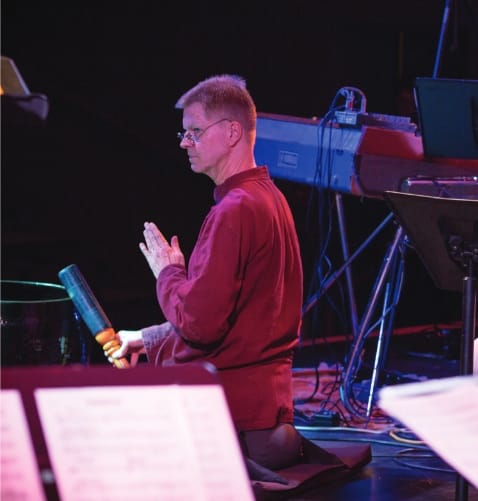Oceans of Vows: A Musical Meditation on Interbeing is based on musical settings of small excerpts from the voluminous Buddhist scripture known as the Avatamsaka Sutra, combined with four-plus thematically related poems by my spiritual teacher, the Vietnamese Zen Buddhist master Thich Nhat Hanh. The performance of the piece very fortuitously fell on the occasion of Nhat Hanh’s 89th birthday (or what he prefers to think of as a “continuation day”) and was consequently offered as both a birthday gift in his honor and a benefit event to raise funds to help defray the cost of the intensive rehabilitation effort that was being given to him in Northern California at the time of the concert following a severe stroke he suffered in the fall of 2014.
A studio recording of the entire piece was made with the ensemble over two days following the piece’s premiere. This artifact, with each part/half of the piece contained on its own disc, represents the fruit of my journey conceiving, realizing, and manifesting the music with the ensemble as it was played during those two days of recording it in the studio.
The Avatamsaka Sutra, also known as the Flower Garland Discourse, the Flower Adornment Scripture, and other similar titles, is a Mahayana Buddhist text that is thought to have been written at least five hundred years after the death of the historical Buddha. Part of the Chinese canon, it is considered likely to be a collection of a number of originally separate scriptures, the result being by far the longest and largest Buddhist sutra, English translations usually totaling well upward of a thousand pages. Relating mindbendingly cosmic themes by using very vivid, elaborate, often celestial imagery and intensely colorful, poetic language, the sutra mainly concerns itself with exploring the thoroughly interrelated, interdependent, interpenetrating, interconnected nature of reality.
Through the fragrant and kaleidoscopic text of the Avatamsaka Sutra, a most thought-provoking view of reality can begin to be glimpsed—the universe in a speck of dust.
Put simply, the sutra advances the idea of one in all and all in one, of the infinitely large being contained within the infinitely small and vice versa, of mind and object of mind being one, and that every aspect of what we perceive as existence is dependent on every other aspect. According to this, everything is intimately interconnected, there is no separateness, and all exists together simultaneously in what we perceive as time and space. A common image used to describe this, and which appears in the sutra, is Indra’s Net, in which each intersection in the infinite web contains a multifaceted jewel which reflects all the other jewels. Through the fragrant and kaleidoscopic text of the Avatamsaka Sutra, a most thought-provoking view of reality can begin to be glimpsed—the universe in a speck of dust.
The sutra’s ideas, though conveyed using radically different language, would probably not be particularly unusual or surprising to anyone today interested in or familiar with many of the most radical and advanced suppositions of modern theoretical physics and cosmology, including and furthering ideas posed by Albert Einstein—quantum mechanics, string theory, and M-theory, for example, are in some ways uncannily similar to material presented in the Avatamsaka Sutra. Of course, its insights are the result of meditation—stopping and looking deeply—rather than of mathematics, the scientific method, or the construction of something as massive in size and cost as the CERN Large Hadron Collider. But the converging of these startling ancient and modern ideas is undeniably exciting and is a subject about which much is currently being discussed and written. Being so in line with much contemporary thinking, I don’t feel that one has to be a Buddhist to find this sutra or its ideas interesting and enjoyable.

In setting some of the Avatamsaka Sutra to music, I am in no way attempting to be persuasive or dogmatic, nor am I trying to advance any agenda or ideas of personal preference relating to theology, religious doctrine, or to schools of Buddhism, be they Theravada, Mahayana, Vajrayana, “self power,” “other power,” or anything else. Personally speaking, more than its remarkably monumental length and complexity or its glorious imagery and dazzling language, the subject matter of this sutra simply interests and inspires me deeply. My first taste of the sutra came via the beautifully reverent text “The Ten Great Aspirations of Bodhisattva Samantabhadra,” a text which moved me profoundly and which I, because of my love of it at the time I encountered it, imagined possibly setting to music someday. Thus the seed was planted for what was to later become; a setting of that text now closes Oceans of Vows.
In fact, the words of that text beautifully and completely express the spirit in which I offer this music. Out of interest, after pursuing more about the sutra and its themes, I kept the idea of perhaps someday setting parts of the sutra to music as an aspiration in the back of my mind, feeling that its inspiring content and its poetic language were both elements for which I could imagine creating a compelling musical context given favorable conditions, despite the rather outsized magnitude of both the sutra’s presentation and its profound concepts. Of course, it would be impossible to even attempt to create an adequate sonic representation of the sutra itself, which alone, after all, forms the core of some Chinese schools of Buddhism (Huayan) in and of itself, but as I sat with the idea and pondered its implications and dimensions, the plan for a large-scale piece of music began to take shape along with the instrumentation of the ensemble I could imagine playing it. Quite unexpectedly, thanks to an extraordinarily generous invitation from the Shifting Foundation to apply for a grant, favorable conditions presented themselves, and Oceans of Vows came to be.
The phrase “oceans of vows” comes from the sutra’s text and is typical of the manner in which its ideas are expressed: “Enlightening beings cultivate the practice of oceans of vows.” The word “oceans” is used throughout the sutra to express vast, immeasurable magnitude. Sometimes the historical Buddha himself, while described as remarkably down-to-earth, accessible, and compelling as a person, is likened to an ocean—deep, immense, mysterious, unfathomable. Here “vow” is not merely a “solemn promise,” as Webster’s defines it, but both an intention and a practice, something ongoing and dynamic, the watering of a seed in the present that will blossom and continue to flower in the future. “Enlightening beings” here are buddhas—awakened beings—and bodhisattvas, great beings who vow to serve and save all beings and even to postpone their own release from the round of birth and death in order to endeavor to ease all suffering. In fact, the sutra is known for its description of the path of the bodhisattva as it unfolds in ten stages.
As impossible as this sounds, and although the sutra makes constant references to the existence of buddhas on an infinite and universal scale, I think it’s important to remember that the historical (Shakyamuni) Buddha was, after all, a human being, Gautama Siddhartha, who awakened and then spent the rest of his life teaching others how to do the same.
I aimed to convey some of the cosmic, hypnotic flavor of this massive sutra while also attempting to ground the experience via the human, the humble, and personal.
Oceans of Vows is, perhaps logically, my biggest work ever, but much of what comprises it is actually quite simple. I aimed to both convey some of the cosmic, hypnotic flavor of the massive sutra while also attempting to ground the experience via the human, the humble, and personal. After all, according to the sutra’s declarations, the Avatamsaka world is not in any way separate from what we perceive to be our world; it is right here, right now.
My strategy for balancing the celestial splendor of the sutra and its at times rather grandiose language with textual content both truly human and personal was to include musical settings of four poems (plus a little extra material) by Thich Nhat Hanh. (Listen to the track “The Old Mendicant,” above; you can read along with Thich Nhat Hanh’s poem, which serve as the track’s lyrics, below.)
I hope that the piece can be thoroughly enjoyed by any- and everyone, textual content notwithstanding. It is my own personal musical meditation on the Avatamsaka Sutra and on its overarching theme of what Thich Nhat Hanh calls “interbeing,” which I offer to the listening audience, as well as a humble expression of gratitude, which I offer to Thay (which is Vietnamese for “teacher” and is how his students refer to him). I felt the title Oceans of Vows suitably reflected both the immensity of the Avatamsaka Sutra, the depth and breadth of its cosmic themes, as well as the tremendous magnitude of the contribution of Thay’s life and teaching, in his case those being one and the same.
I offer this music toward the awakening, transformation, healing, and benefit of all beings. And a deep and humble bow of gratitude to my teacher, Thich Nhat Hanh, for “incalculable” inspiration. “I know because you are there that I am here.” You continue to be in me.
Excerpted and adapted from Alex Cline’s liner notes for Oceans of Vows, by Alex Cline’s Flower Garland Orchestra, with permission of the author and Crypotogramophone.
“The Old Mendicant”
by Thich Nhat Hanh
Being rock, being gas, being mist, being Mind,
being the mesons traveling among the galaxies
at the speed of light,
you have come here, my beloved.
And your blue eyes shine, so beautiful, so deep.
You have taken the path traced for you
from the non-beginning and the never-ending.
You say that on your way here
you have gone through
any millions of births and deaths.
Innumerable times you have been transformed
into firestorms in outer space.
You have used your own body
to measure the age of the mountains and rivers.
You have manifested yourself
as trees, grass, butterflies, single-celled beings,
and as chrysanthemums.
But the eyes with which you look at me this morning
tell me that you have never died.
Your smile invites me into the game
whose beginning no one knows,
the game of hide-and-seek.
O green caterpillar, you are solemnly using your body
to measure the length of the rose branch that grew last Summer.
Everyone says that you, my beloved, were just born this Spring.
Tell me, how long have you been around?
Why wait until this moment to reveal yourself to me,
carrying with you that smile which is so silent and so deep?
O caterpillar, suns, moons, and stars flow out
each time I exhale.
Who knows that the infinitely large must be found
in your tiny body?
Upon each point in your body,
thousands of Buddha fields have been established.
With each stretch of your body, you measure time
from the non-beginning to the never-ending.
The great mendicant of old is still there on Vulture Peak,
contemplating the ever-splendid sunset.
Gautama, how strange!
Who said that the Udumbara flower blooms
only once every 3,000 years?
The sound of the rising tide—you cannot help hearing it
if you have an attentive ear.
(Reprinted from Call Me By My True Names, with permission of Parallax Press.)

